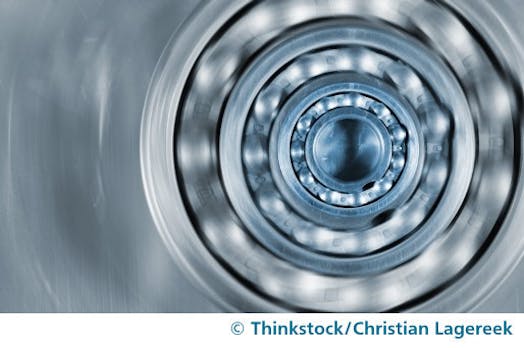From 10,000ft under the sea to 40,000ft above: how PEEK is shaping the industrial world
Mobile phones the size of house bricks? Air travel being luxurious? Manufacturing based on a manual workforce? Can you remember back to the 1980s? This was when VICTREX™ PEEK polymer was first commercialised and truly challenging industrialised conditions were rare. Car engines only reached between 100–120°C in some areas and oil and gas exploration focused mainly on shallow drilling.
However, while these were seen as extremes in their time, they are nothing compared to the levels of extremity found in many industries today. Driven by progression in engineering, advances in technology, and human demand and capacity for more goods and energy, the conditions under which many industries operate are pushing boundaries once considered impossible.

So let’s explore some of the design challenges faced and how new solutions are overcoming obstacles and creating new growth opportunities.
Challenge #1 – Driving greater efficiencies
The automotive sector provides excellent examples of driving efficiencies in extreme environments. Car makers have been looking, for example, at the entire powertrain to find ways to reduce emissions and improve fuel savings, driven by legislation for more environmentally friendly vehicles. But the materials used in these powertrain components must be able to meet a number of key requirements at the same time, for example handle harsh settings and high temperatures or deliver longer durability was required.

With the knowledge around high performing thermoplastic materials spreading visionary design engineers and material pioneers are partnering to set the course for future developments using high-performance polymers as an alternative in certain metal dominated areas to help solve identified challenges.
Today´s electronic braking systems serve as a proof point for successful metal replacement, with more than 200 million drivers relying on VICTREX PEEK-based braking systems. The same applies to gears. Although a small component, replacing metal gears is having a big impact. Compared to metal gears “VICTREX gear technology” enables up to 68% weight reduction along with a 50% (3dB) reduction in noise, vibration and harshness. In addition, the moment of inertia can be reduced up to 78%. This translates in improved responsiveness and consequently lower power consumption contributing to lower CO2 emissions.
Challenge #2 – Meeting reliability targets and reducing downtime
Industrial progression also has its by-products. One of them is the requirement for more energy for use in everything from air travel to manufacturing. As a consequence, the oil and gas sector had to go deeper and deeper to extract from new non-conventional oil reserves to meet increasing energy demands. Along with that came the extremes of high pressures, high temperatures, aggressive chemicals, and corrosive environments.
In this unforgiving environment the necessity for extended service life, enhanced operational safety, and improved recovery becomes more critical. Every instance of offshore platform, undersea pipe or drilling equipment must be able to withstand such surroundings to meet set targets and avoid costly downtimes. Just imagine the implications of an average $400,000 per day cost of deep water drilling rates, with an industry average of 5-10% downtime due to tool failures.
Progressive organisations have adopted PEEK materials to deliver high levels of reliability and to minimise risks, with benefits including the potential to double the service life of electrical connectors or a two times higher load bearing capacity of sealing systems. Read more
Challenge #3 – Quicker part manufacturing and assembly with smart(er) designs
At 40,000 feet above, the aerospace industry faces design challenges with the fluctuations of pressure and temperature and the need for CO2 reduction, combined with stringent legislation and regulatory needs to ensure the safety of passengers is paramount.
However there is an additional hurdle. Over the next 20 years, the global aerospace industry is predicted to require more than 35,000 new aircraft. So manufacturers have to increase the pace at which new aircraft are assembled, without conceding on function, cost or weight.
Consequently aircraft OEMs are looking for ways to simplify the manufacturing processes, such as consolidating the number of parts through designing highly functional injection moulded PEEK components. And the next improvement is already on the horizon using new composites (VICTREX AE™ 250), to develop parts in combination with a special technology, the hybrid moulding process. This can offer continuous manufacturing processes and cycle times measured in minutes versus hours for thermoset alternatives - and deliver clear competitive advantages. Structural brackets serve as a great example. In addition to speeding up the manufacturing of parts and the assembly of aircrafts, they can deliver up to 60% reduction in weight compared to metals, while meeting the required strength of the components. Already today, more than 15,000 aircraft take-off with PEEK-based solutions on board.
Challenge #4 – Meeting a continued demand to improve performance
In an increasingly connected world we want thinner, lighter, smarter and always-on devices. Our desire for technology seems insatiable as consumers increase their daily usage of mobile electronic devices, in cases up to five hours a day.
The demands of this ever-evolving landscape deliver a unique set of challenges to electronics companies. Where the requirement for unfailing high quality technology is a vital success factor. The daily wear and tear from being dropped, getting wet, and being exposed to chemicals components such as in sunscreen or the desire for thin, light and smart devices has led designers to look for high-performing, durable material solutions. For the mobile device, for example, they found it in the form of PEEK-based APTIV™ film technology for acoustic applications. The high-performing plastics film is ultra-thin and a perfect fit without compromising on performance.
How does this help with the extremes of tomorrow?
As the pace of technological development, alongside societal needs, continues to accelerate, so too will the boundaries within which applications have to operate. When combined with a global desire to reduce the carbon footprint; consumer demands for more reliable goods and state-of-the art technology; and streamlined manufacturing processes, ambitious businesses are looking for ways to reinvent themselves.
In reconsidering materials used within applications, manufacturers have the opportunity to deliver the required future performance for them to succeed today – and to achieve the art of the possible in the extremes of tomorrow.



